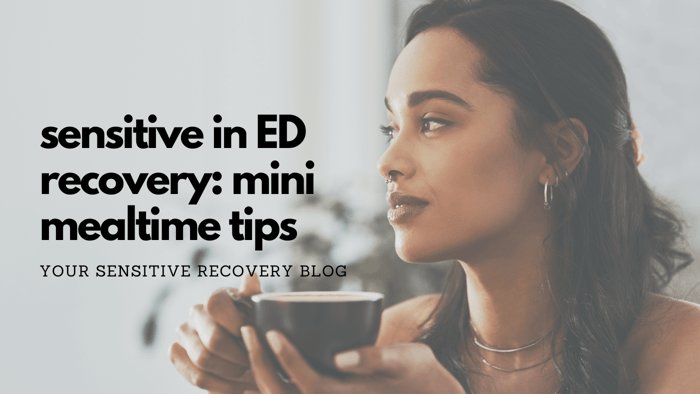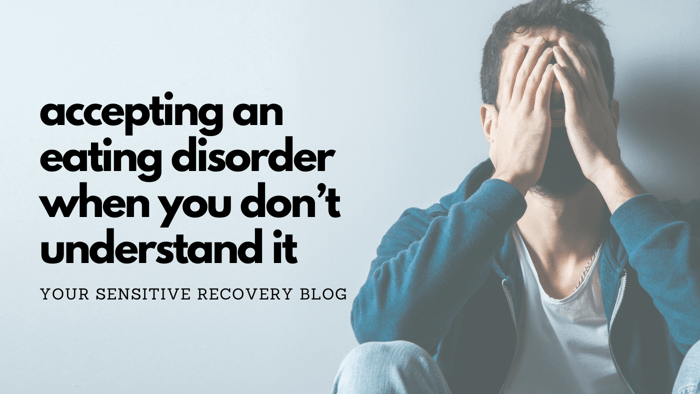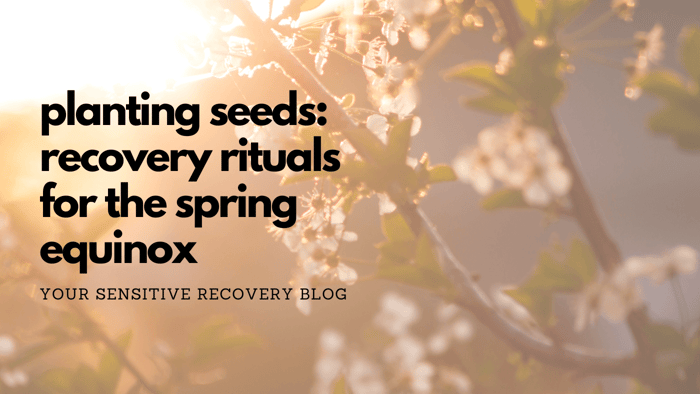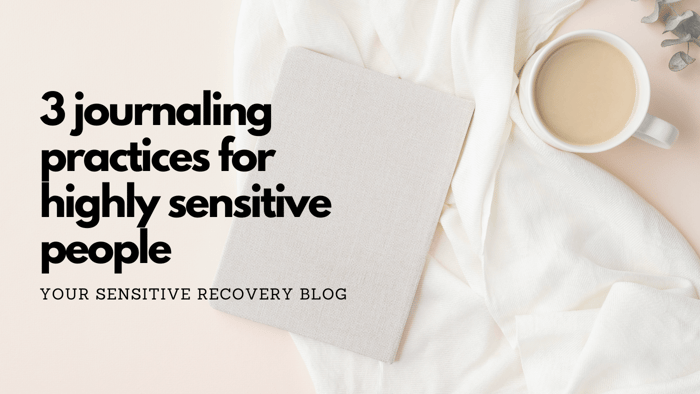Eating can of course be incredibly stressful for individuals in eating disorder recovery. Highly Sensitive People can find mealtimes especially challenging, as eating disorder thoughts mix with physiological stress and anxiety, and potential sensory overload.
This is a recipe for a terrible time.
When I was in eating disorder treatment, I didn't have a say in what was on my menu for my daily meals. Granted, I was not in a place to choose items that would have given me both the nutrients and joy in food that I enjoy now in my recovered life.
But it stands out to me how little my HSP needs were recognized and tended to back then.
At this time in my life, I knew I was sensitive. Incredibly sensitive. But I didn't know that Sensory Processing Sensitivity (SPS is the scientific term for High Sensitivity) was a thing, or that I experienced it alongside 20-30% of the population. I didn't know that SPS can add an extra layer of challenge to eating disorder recovery and that treatment experts are not always aware of what it is or how to support someone with it.
Here's an example of what I mean.
Each meal in this treatment center was a time to practice "gentle eating," meaning Staff put on soft music and the other residents and I sat cafeteria-style while our food was delivered on covered trays. There wasn't much talking. It wasn't discouraged per say, but connecting over food certainly wasn't encouraged either.
We all mostly went through these meals with just our screaming eating disorder thoughts as company.
Most mornings I was given a little single-serve packet of peanut butter, either to eat with an apple, on toast, or perhaps in my oatmeal. Now, I love peanut butter. I love it now and I loved it then. My eating disorder was a little scared of PB, but being the people-pleasing, perfectionistic patient I was, I would have risen to the challenge of eating it, no problem...except for the ONE problem.
The smell of peanut butter in the morning made me ill.
Any other time of day was fine. But in the morning? I. Could. Not. Tolerate It. I don't know why.
I often wound up in tears over the peanut butter, fighting hard to keep my gag reflex at bay while I choked it down. My cries and pleas to staff to substitute ANY OTHER FOOD were ignored or dismissed. My issue was chalked up solely to my eating disorder being in control.
"It's your eating disorder talking. It'll be fine. It's this or a supplement." (If often ended up being the latter.)
Thankfully, times have changed. Most treatment facilities give their clients at least some menu choices and the chance to choose food "dislikes" that will not be served. There is now a greater (albeit far from perfect) understanding of sensory processing needs in recovery and beyond.
Here are some Mini Mealtime Tips to help make eating in recovery a tad easier for Highly Sensitive People:
- Be willing to examine your choices, and then...trust yourself. For the sake of your recovery process, it's important to be curious about whether your food choices are based on satisfying your eating disorder or your true preferences (how something tastes, smells, feels, digests, etc.). Once you do the work, you can trust yourself. You are the expert on you, always.
- Advocate for yourself. You'll likely need to share with at least some of your support network about your sensitivity and any sensory needs. If your recovery includes a treatment program (and it's still 100% valid and important if doesn't), make sure the staff is aware of SPS and how your needs might be accommodated. Food Exposures should only be done with your consent.
- Find some stability. This might seem super simple but it could be really helpful for you while you're eating or whenever you're experiencing stress: try placing one hand flat on the table, or whatever surface you're eating on. Bring your awareness to the feeling of the surface under your palm. Notice the sturdiness, texture, and temperature of the material. Leave it there for as long as you need while you eat (unless of course, two hands are required for your food).
- Sigh it out. When our bodies sigh or yawn they're regulating our CO2 levels and taking care of our lungs. It just so happens that we're relieving stress too. Inducing a sigh is a simple and easy way to shift out of fight-or-flight. After a deeper-than-normal inhale through your nose, top it off with an additional inhale before you release and breathe out through your mouth. Your body may like this so much that it's followed automatically by an additional sigh or yawn. Repeat as desired throughout your meal.
- Transition with intention: I talk about this one a lot! Make sure that you are giving your nervous system time to adjust when transitioning from one event or situation to another. Take a minute or two at the start and end of your meal to check in with your emotions, your thoughts, and your sensations with a simply curious, non-judgmental stance. You could rate your hunger-fullness if that's helpful. Do an intentional sigh or two, feel your feet on the ground or your hand on the table, and then continue about your day.
- Create a relaxing environment: You can help reduce the potential for sensory overwhelm by putting some thought into your eating space. This is highly personal, so be prepared to experiment! You may be immensely helped by neutral dialogue with your meal companions. Or you may prefer not to talk much. TV, music, or reading material may be fantastic for your sensory needs, or they may add unhelpful distraction if you're trying to increase your meal mindfulness. Pay attention to things like the utensils you like the most, the napkins that feel good to you, and your Goldilocks food temperature. It's your right to make mealtimes work for you.
- Practice patience with yourself. What you're doing is not easy. All of the unhelpful things people may have said to you during your struggles are extremely over-simplifying and dismissive. ("Just eat", "Just stop eating", "Just eat normally", etc.) If only it were that simple. Take a brief moment at the end of your meal to thank your body for using the nutrients for your greatest good, and thank yourself for doing hard things.
By the way, I'm totally chill with peanut butter in the morning now. 😋
That might be due to the forced exposures all those years ago, or simply the fact that things are constantly changing, our sensitivity and sensory processing included. (There are actually some food textures that bother me now that didn't much back then.) Who knows. But I know my needs and limits. I choose to take care of myself. I hope you choose that for yourself too.
You're worth it.
✨ Josie Munroe, LMFT is a licensed therapist and owner of JosieMunroe.com and Your Sensitive Recovery As a recovered clinician and Highly Sensitive Person, she loves supporting others on their journeys to form new, empowered relationships with food, their bodies, and their sensitivity. Join the newsletter for a weekly boost of hope and inspiration. You deserve a recovery that works for you! ✨





